Ijraset Journal For Research in Applied Science and Engineering Technology
- Home / Ijraset
- On This Page
- Abstract
- Introduction
- Conclusion
- References
- Copyright
A Study on the Fintech Penetration in Rural Karnataka
Authors: Mr. Sunil R. Hegde, Ms. Vyshnavi A, Pratham Jain, Harsh Jain, Yash Dudhoria, Rishin Jain, Nikhil Rathod
DOI Link: https://doi.org/10.22214/ijraset.2024.60020
Certificate: View Certificate
Abstract
In the financial services sector, financial technology, or Fintech, has become a disruptive force, especially when it comes to expanding financial inclusion. In order to comprehend the degree of acceptance, the effect on financial inclusion, and the difficulties encountered, this paper presents a study on the penetration of Fintech services in rural Karnataka, India. The study uses a mixed-methods approach to collect data from important stakeholders, non-users, and Fintech users. The methods include surveys, interviews, and case studies. The results show that although the adoption rate of Fintech services is still relatively low, they have begun to spread to rural areas. Adoption is hampered by elements including low awareness, problems with trust, and a lack of digital infrastructure. The paper discusses strategies to promote Fintech adoption in rural Karnataka, including awareness campaigns, improving digital literacy, and enhancing digital infrastructure. The study concludes that increasing Fintech penetration in rural areas has the scope to significantly enhance access to finance and improve overall economic well-being of rural communities in Karnataka, India.
Introduction
I. INTRODUCTION
The evolution of fintech in India has been a remarkable journey marked by transformative shifts in the financial landscape. Beginning modestly with the introduction of electronic stock exchanges and payment systems in the late 20th century, fintech gained momentum in the early 2000s with the advent of internet banking and digital payment gateways. Regulatory reforms in the 2010s, such as the launch of UPI and the licensing of non-banking financial companies (NBFCs) and payment banks, laid the groundwork for unprecedented growth. Peer-to-peer lending services, investment platforms, and digital wallets all flourished during this time, completely changing the way Indians conduct business and handle their funds. Furthermore, programs like Aadhaar-enabled systems and demonetization hastened the uptake of digital payments and encouraged financial inclusion. In the future, fintech in India is expected to be driven by technologies such as blockchain and artificial intelligence (AI), with a particular emphasis on meeting the requirements of underserved areas and maintaining regulatory compliance. The way financial services are offered and accessed globally has radically transformed as a result of fintech, or financial technology. In India's cities, fintech—which provides innovative solutions for lending, investing, payments, insurance, and insurance—is growing in popularity.
The state of Karnataka in southern India provides a great case study for examining the adoption of Fintech in rural areas. Karnataka is a powerhouse for innovation and technology, but in rural regions, access to basic financial services remains a challenge. The present research endeavors to examine the present condition of Fintech penetration in rural Karnataka, emphasizing the degree of acceptance, the determinants of adoption, and the consequences for financial inclusion.
By investigating these aspects and providing insights that could inform policy decisions and strategies to promote Fintech adoption in rural areas, this study seeks to advance the body of knowledge on Fintech and financial inclusion in India.Policymakers, financial institutions, and Fintech firms might find the study's conclusions useful in developing more equitable and practical financial solutions for rural Karnataka and beyond.
A. Objectives of the Study
For my research, we chose the following objectives:
- To assess the extent of Fintech penetration in rural Karnataka.
- To explore key factors influencing for the adoption of Fintech solutions.
- To identify the challenges countered by the Fintech companies in expanding their services.
- To assess consumer behavior and response to Fintech solutions.
- To determine how the adoption of Fintech affects financial inclusion.
II. REVIEW OF LITERATURE
- Mehrotra, A. (2019, April), A call for financial inclusion and inclusive growth is being heard from an increasing number of nations as they come to understand that inclusive growth is more sustainable. The FinTech revolution, which questions the responsibilities played by traditional players in promoting inclusivity, has come just after this awakening.
- Raj, B., & Upadhyay, V. (2020). The system is expanding every day because more and more individuals are switching from cash to cashless transactions as a result of the market's globalization and the expansion of the financial industry. The cashless system is both necessary and vital in today's environment. An important shift in regulations and policies has led to a notable increase in the number of bank accounts that are available. However, it has proven to be exceedingly difficult to use these accounts and to accept formal financial services other than savings accounts.
- Badruddin, A. (2017).Fintech is widely used in achieving inclusive financial goals. It is clear that the financial system is evolving. When used creatively, conventional banking technologies have significantly decreased costs and expanded the scope and adoption of the microfinance concept. Over the years, several significant innovations from the formal financial sector have made their way into microfinance.
- Kukreja, G., Bahl, D., & Gupta, R. (2021), Fintech is a new buzzword in the context of the fourth industrial revolution. These new technologies have an impact on all financial services worldwide. Blockchain, artificial intelligence, data analytics, and remittances have impacted many aspects of financial services, such as deposits, transactions, bills, remittances, credits (B2B and P2P), underwriting, insurance, and so on. More individuals may now access financing, live better lives, make wiser decisions, and do a lot more thanks to fintech companies. This chapter explores the expansion, prospects, and issues facing the Indian financial sector as a result of new technology.
- Kaur, J. (2019). The transformation that has become increasingly significant in recent years is called fintech.There is a push to change the traditional methods of doing work. We attempted to cover a few significant issues facing the Fintech sector as well as some significant disruptions seen in the financial services industry in this piece. The paper is descriptive in character and presents and analyzes Fintech industry developments using secondary data. This study will be helpful to everyone who wants to learn about the most recent advancements in the Fintech industry from a variety of angles.
- Prasanna, P. (2023, February). Numerous technology platforms are utilized to standardize rural development projects. If utilized effectively, the majority of agricultural technology and fintech will drastically reduce farming costs. Fintech has helped to remove poverty from community frames, while anking technology has lowered operational expenses and enhanced corporate transparency. The purpose of this study was to help banks and other institutional lenders figure out how best to employ fintech-enabled lending solutions in rural areas and at what scale.
- Goswami, S., Sharma, R. B., & Chouhan, V. (2022). The economy as a whole has growth prospects thanks to the transition to financial technology. Furthermore, it is clear that the emergence of digital transformation has played a significant role in the growth of FinTech efforts, which are regarded as some of the most significant advancements in the financial sector. End users' behavioral intention and their use of financial technology services and systems are positively connected. The system's usability and variables that affect how simple financial technology is viewed to be to use are positively correlated.
- Asif, M., Khan, M. N., Tiwari, S., Wani, S. K., & Alam, F. (2023). This study examined this influence using secondary data from the RBI as well as regression and correlation. The primary objective was to ascertain how fintech and digital financial services impact financial inclusion in India. The results show that fintech firms have significantly boosted financial inclusion in our nation, especially for Americans in the middle class. These results will be helpful to policymakers who are working hard to incorporate every resident of this country into a well-functioning financial system.
- Pant, S. K. (2020), India is home to three of the world's top fintech firms, making it one of the industries with the greatest rate of growth in both developed and developing nations. A few of the emerging trends highlighted by the IMF are the use of distributed ledger technology to leverage fintech for cross-border payments, the use of augmented reality to boost customer satisfaction, digital insurance, digital invoicing, crowd-funding, crowd investing, robotics investment advisory, potential future bank-fintech partnerships, and the regulatory role of central banks.
- Virani, S., Rautela, S., & Sharma, S. (2021).The last few decades have seen significant changes to the extremely diversified Indian financial sector. The easiest way to explain the changes is to look at the new players that are joining the Indian financial sector and the rapid expansion of the financial services that are already there. Additionally, it looked into how the Indian banking industry may be completely transformed and reshaped in order to fully grasp the potential of fintech.
- Mathew, A., & Shivani, M. P. (2024),The last few decades have seen significant changes to the extremely diversified Indian financial sector. The easiest way to explain the changes is to look at the new players that are joining the Indian financial sector and the rapid expansion of the financial services that are already there. Additionally, it looked into how the Indian banking industry may be completely transformed and reshaped in order to fully grasp the potential of fintech.
- Cnaan, R. A., Scott, M. L., Heist, H. D., &Moodithaya, M. S. A survey of 3,159 households in seven Indian states' villages was conducted by Research (2024). Based on the data, it can be concluded that there was little to no financial inclusion through digital banking in both the cashless villages and the comparator villages. Despite significant state variations, it was shown that internet availability and financial literacy were the best predictors of engaging in any kind of digital banking activity. The study's conclusion warns against rushing the establishment of digital banking and a cashless society since these measures may exclude vulnerable populations.
- Chandran, P., Chinnasamy, G., Vinoth, S., Reddy, P. S., & Chinnasamy, G.(2024)According to this study, digital banking adoption in rural India is still in its infancy and there is a difference in the use of digital banking channels, such as e-wallets, between consumers in urban and rural areas (Deepesh Ranabhat et al., 2022). Through the use of both quantitative and qualitative research methodologies, this study aims to determine the factors that impact rural customers' perceptions of e-wallets and their inclination to use them.
- Raj, R. (2022). The current study's goal is to examine the idea of digital payments as well as the effects of COVID-19 on these services, particularly at the grassroots level, or in India's towns and villages. The secondary research includes some opinions or observations from other researchers who have shared their expertise on similar topics. The study's result demonstrates that, in Indian towns and villages, there has been a significant increase in the usage of digital payment services through a variety of applications, compared to before the global pandemic of COVID-19.
- Kumar, A. C.(2024).The study's goal is to understand the function of financial inclusion through self-help groups. To that end, secondary data will be gathered from banks, NGOs, and NABARD. Research indicates that financial inclusion is a key program for a nation's sustainable growth and a potent instrument for achieving inclusive growth. For the whole public to be included in the development orbit, inclusive growth is important. Only by making finance available to all segments of society will social and economic fairness be possible.
III. RESEARCH METHODOLOGY
- Primary Method: For the primary data, a questionnaire was designed with 10 questions about the fintech industry and used a random sample of 54 respondents to provide information. These inquiries would clarify our understanding of our research topic and aid in our pursuit for additional information.
- Secondary Method: The data was collected through various newspaper articles, books,research papers,research articles and websites.
IV. DATA ANALYSIS
The data was gathered through the primary and secondary sources. For primary data, a Google form with relevant questions was used to gather the views and responses of people living in the rural landscape. The data collected through the same is demonstrated below.
1) Do you have a bank account?
|
Options |
No. of Responses |
Percentage |
|
Yes |
47 |
94% |
|
No |
3 |
6% |
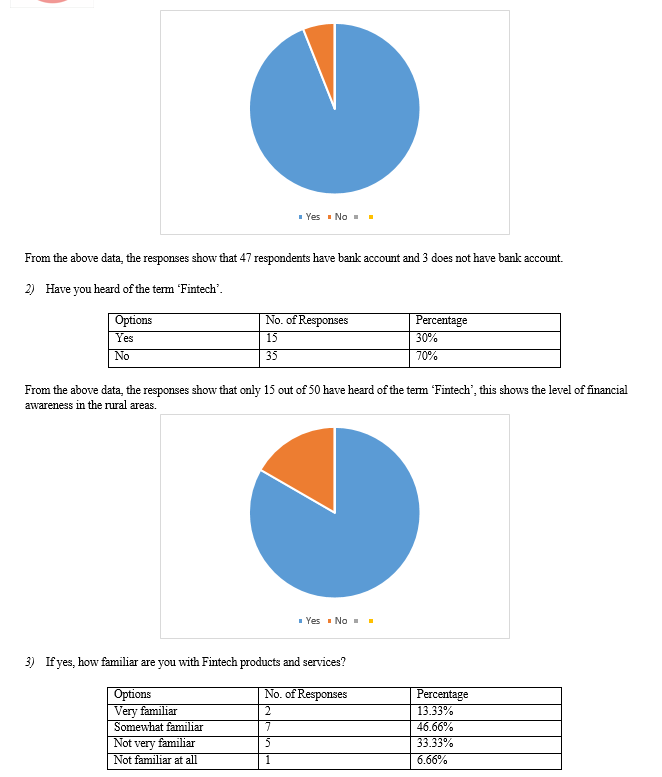
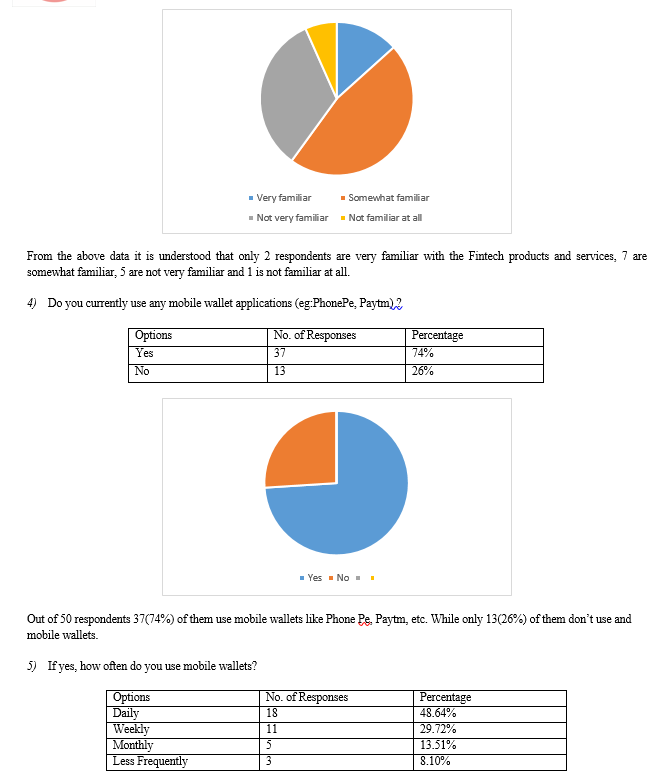
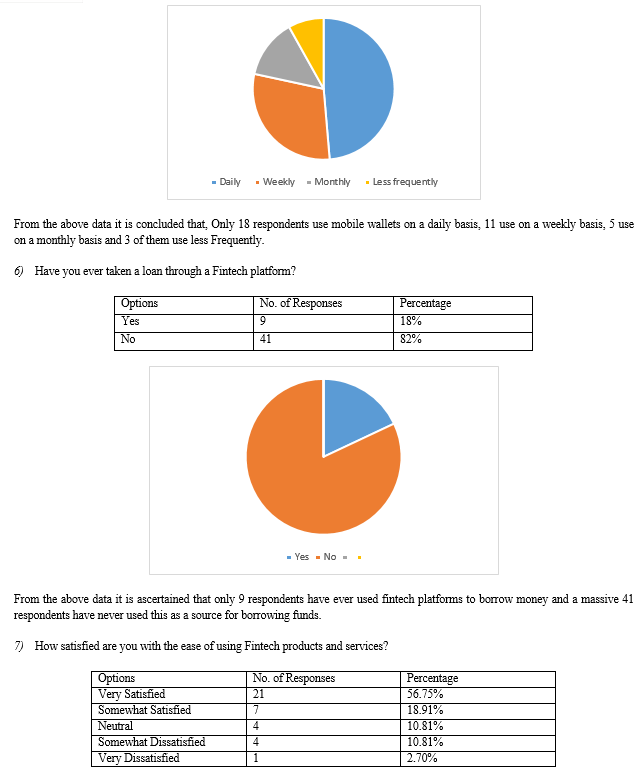
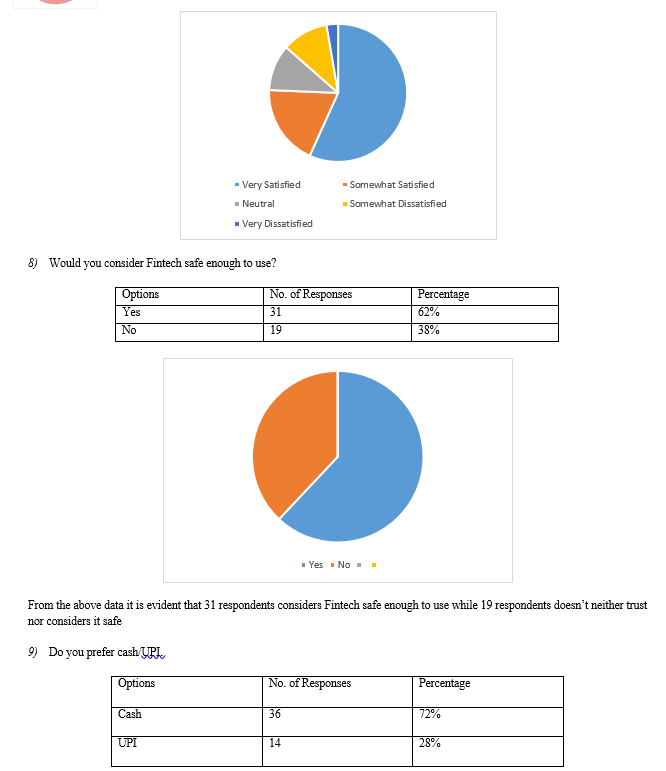
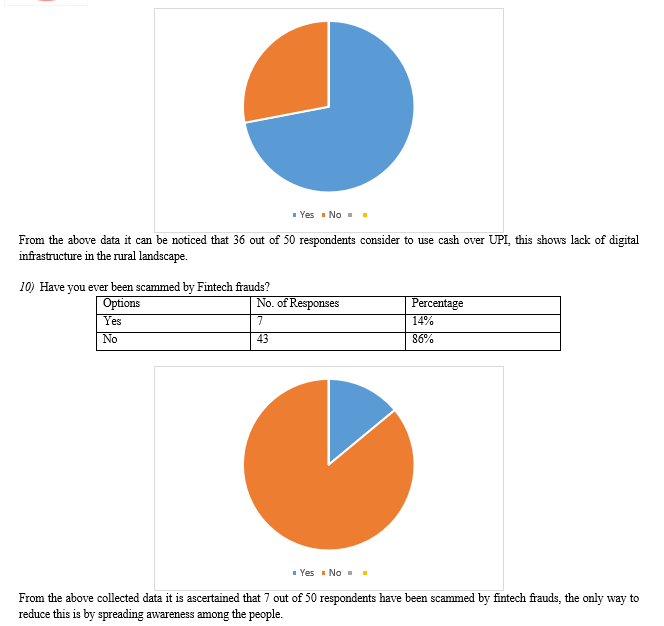
V. FINDINGS
- Adoption Rate: According to the survey, Fintech service uptake is comparatively low in rural Karnataka.
- Factors Influencing Adoption: Three main factors—convenience, affordability, and accessibility—are driving the uptake of Fintech services in rural Karnataka. Yet, there were also major obstacles to adoption, such as mistrust and ignorance.
- Usage Patterns: Among those who have used Fintech services, the most common purposes were digital payments and savings. Fewer respondents reported using Fintech services for loans, insurance, or investment.
- Digital Infrastructure: Access to smartphones and the internet was limited, with only [85%] of respondents owning a smartphone and [58%] having access to the internet. This lack of digital infrastructure hinders the widespread adoption of Fintech services in rural areas.
- Impact on Financial Inclusion: Despite the low adoption rate, Fintech services have had a positive impact on financial inclusion in rural Karnataka. Those who have adopted Fintech services reported greater access to banking services and increased financial literacy.
VI. SUGGESTIONS
- Awareness Campaigns: There is a need for targeted awareness campaigns to educate rural residents about the benefits and functionalities of Fintech services. These campaigns should be conducted through local channels and in regional languages to reach a wider audience.
- Improving Digital Literacy: Efforts should be made to improve digital literacy among rural residents, particularly among older age groups and those with lower levels of education. This can be done through training programs and workshops conducted in collaboration with local organizations.
- Enhancing Digital Infrastructure: There is a need to improve access to smartphones and the internet in rural areas. This could be achieved through government initiatives to expand digital infrastructure and promote affordable smartphone options for rural residents.
- Tailored Fintech Solutions: Fintech companies should develop solutions that are tailored to the specific needs and challenges of rural communities. This could include simplified interfaces, low-cost services, and solutions that cater to the unique financial requirements of rural residents.
- Collaboration with Local Stakeholders: Collaboration with local governments, NGOs, and community organizations is essential to promote Fintech adoption in rural areas. These stakeholders can help in disseminating information, building trust, and addressing the specific needs of rural communities.
Conclusion
According to a study on the adoption of fintech in rural Karnataka, India, the situation is complicated and full of prospects and problems. Fintech services are beginning to find their way into rural areas, but adoption rates are still low because of things like restricted access to digital infrastructure, lack of understanding, and problems with trust. Fintech services have improved financial knowledge among rural communities and increased access to banking services, despite these obstacles to financial inclusion. Even while Fintech adoption in rural Karnataka is still in its infancy, the overall results show that there is a lot of space for growth.
References
[1] Mehrotra, A. (2019, April). Financial inclusion through fintech–a case of lost focus. In 2019 International conference on automation, computational and technology management (ICACTM) (pp. 103-107). IEEE. [2] Raj, B., & Upadhyay, V. (2020). Role of FinTech in accelerating financial inclusion in India. In 3rd International Conference on Economics and Finance organised by the Nepal Rastra Bank at Kathmandu, Nepal during February (pp. 28-29). [3] Badruddin, A. (2017). Conceptualization of the effectiveness of Fintech in financial inclusion. International Journal of Engineering Technology Science and Research, 4(7), 960-965. [4] Kukreja, G., Bahl, D., & Gupta, R. (2021). The impact of Fintech on financial services in India: Past, present, and future trends. In Innovative strategies for implementing Fintech in banking (pp. 191-200). IGI Global. [5] Kaur, J. (2019). Growth potential and challenges for fintech in india. Future of FinTech: Innovative Business Model for Financial Inclusion, 37. [6] Prasanna, P. (2023, February). Fintech-Enabled Financial Inclusion for Rural Networking. In The International Conference On Global Economic Revolutions (pp. 28-38). Cham: Springer Nature Switzerland. [7] Goswami, S., Sharma, R. B., & Chouhan, V. (2022). Impact of financial technology (Fintech) on financial inclusion (FI) in Rural India. Universal Journal of Accounting and Finance, 10(2), 483-497. [8] Asif, M., Khan, M. N., Tiwari, S., Wani, S. K., & Alam, F. (2023). The impact of fintech and digital financial services on financial inclusion in India. Journal of Risk and Financial Management, 16(2), 122. [9] Pant, S. K. (2020). Fintech: Emerging Trends. Telecom Business Review, 13(1). [10] Virani, S., Rautela, S., & Sharma, S. (2021). Financial inclusion via Fintech: A conceptual framework for digitalizing the banking landscape of rural India. In Artificial Intelligence and Speech Technology (pp. 497-505). CRC Press. [11] Mathew, A., & Shivani, M. P. A STUDY ON TRANSFORMATION OF BANKING SECTOR AFTER THE EMERGENCE OF FINTECH IN INDIA [12] Cnaan, R. A., Scott, M. L., Heist, H. D., &Moodithaya, M. S. (2023). Financial inclusion in the digital banking age: Lessons from rural India. Journal of Social Policy, 52(3), 520-541 [13] Chandran, P., Chinnasamy, G., Vinoth, S., Reddy, P. S., & Chinnasamy, G. Accelerating Financial Inclusion in Rural India through the Acceptance and Diffusion of E-Wallets. [14] RAJ, R. (2022). DIGITAL PAYMENT IN RURAL REGION IN INDIA. INTERNATIONAL JOURNAL OF SOCIAL SCIENCE & INTERDISCIPLINARY RESEARCH ISSN: 2277-3630 Impact factor: 7.429, 11(11), 522-532. [15] KUMAR, A. C. AN REVIEW OF FINANCIAL INCLUSION THROUGH SHGs IN INDIA: WITH SPECIAL REFERENCE TO DEVANAHALLI TALUK OF BANGALORE RURAL DISTRICT IN KARNATAKA.
Copyright
Copyright © 2024 Mr. Sunil R. Hegde, Ms. Vyshnavi A, Pratham Jain, Harsh Jain, Yash Dudhoria, Rishin Jain, Nikhil Rathod. This is an open access article distributed under the Creative Commons Attribution License, which permits unrestricted use, distribution, and reproduction in any medium, provided the original work is properly cited.

Download Paper
Paper Id : IJRASET60020
Publish Date : 2024-04-08
ISSN : 2321-9653
Publisher Name : IJRASET
DOI Link : Click Here
 Submit Paper Online
Submit Paper Online

